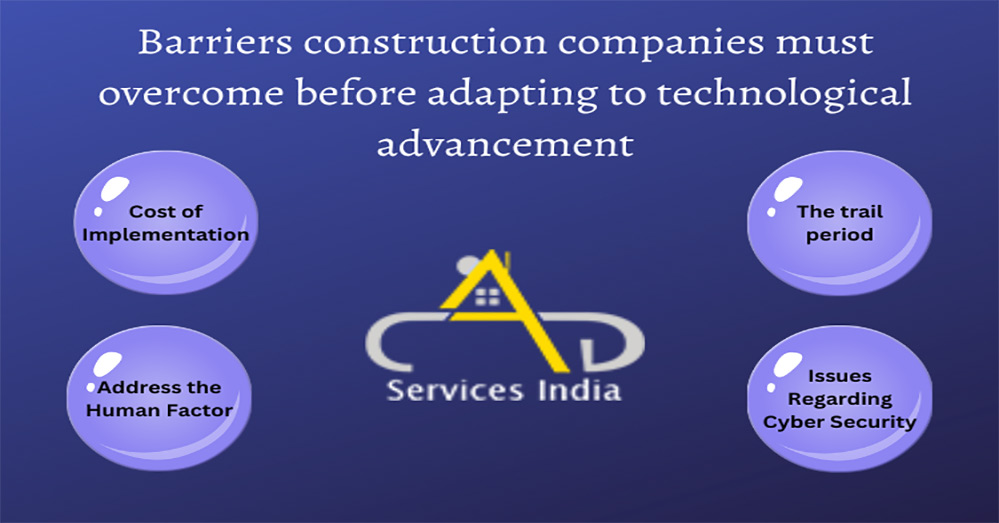
It is an undeniable fact that the construction sector has been historically show to change. It often relies on traditional age-old methods to drive results rather than adapting new technologies. There could be a variety of reasons why AEC companies might be hesitant to incorporate new technological advancements like unwillingness to move out of their comfort zone, cost ramifications etc. However, the fact remains that if they want to drive project performance and improve their productivity and profit then they must embrace technological advancements. Here, in this article we discuss what are the new evolving technological advancements taking place in the construction sector and the barriers hindering their adoption.
To start off the most beneficial and prominent construction technology trend will be digital construction. What started with Drafting Services, digital preconstruction has today evolved to Building Information Modeling. It provides construction professionals all the tools they would need to plan, design, construct and manage buildings and structures. It drastically improves precision and productivity by detecting clashes, improving communication and facilitating collaboration. Ultimately, digital construction technologies through BIM and Common Data Environment enables a comprehensive, detailed and broad view of all phases of project, aiding in mitigating risk and avoiding problems that can cause cost and time ramifications.
Table of Contents
BIM has also allowed to bring to fruition a lot of other technological advancements like prefabrication and 3D printing. A step away from the traditional methods of construction prefabrication and 3D printing are more sustainable, fast and accurate. They allow to be more innovative in their processes as well as the use of materials. Using BIM ensures that accuracy in buildings and structures constructed via these methods. Similarly, drones are being increasing used for supervision, robotics for carrying out repeated tasks etc. Finally, even VR and AR can be used for the purpose of training, presentations etc.
The above technological advancements aim to bring a solution to lack of labour and also provide the AEC companies as a method to overcome their challenge of low-profit margins. It might seem that adapting these new methods is an obvious solution however there are some reasons which are still stopping construction companies.
One of the most common barriers that stop construction companies from adapting new technology is cost attached to it. There is firstly the cost of the technology i.e. the hardware and software requirements which are then compounded by the cost of training, deployment etc. However, in order to leverage technology the companies must change their perception. They must understand that while new technology will take some upfront investment they will also remove inefficiencies, reduce cost over time and ultimately show improvements in profits. This is a matter of investment and if they don’t make the necessary investments now then they will fall behind and lose out on more money over time.
Whenever any change is brought about there will be a small transition period in which the company acclimates to new change in processes, technology and methods. This might see a dip in productivity and overall output. But company must again understand that this is just a passing phase and once they team understands how to best utilize the new technology they will be able to reap maximum benefits. One another way to reduce the impact of trial period is to move in phases where some people might be working on full capacity by traditional methods while others slowly transition.
This could get a little complicated because many times the company might find that their team is unwilling to sit in training for hours or change their workflow. The company must try to firstly get the whole team on board. It could be by showcasing the benefits and the stating the necessity of evolving. They can target the key influencers in the company and first get them on-board so that the others can follow. However, they must also be mentally ready for some resistance and in the worst case scenario even be willing to part with the people who refuse to adapt new technology.
In the age of internet there will always be a small possibility of cybersecurity breaches. The companies have the right to worry about ransomware attacks, data breaches that could gain access to employee data, material pricing, financial records etc. The companies must be cautious of course but instead of letting this deter them just be cautious. They can mitigate the risk of cyber-attack by creating a plan which properly covers the security of project management. Must also invest in various tools and software which take adequate protection measures. Finally, they must also educate the employees about proper cyber security measures so they too remain alert and cautious.
The AEC companies must at this point realize that the construction industry has evolved and adapted to the processes such as BIM Services and if they refuse to do so they might face potential loss as well as over time become redundant. There is always a small risk involved in change but refusing to change altogether might be even riskier.